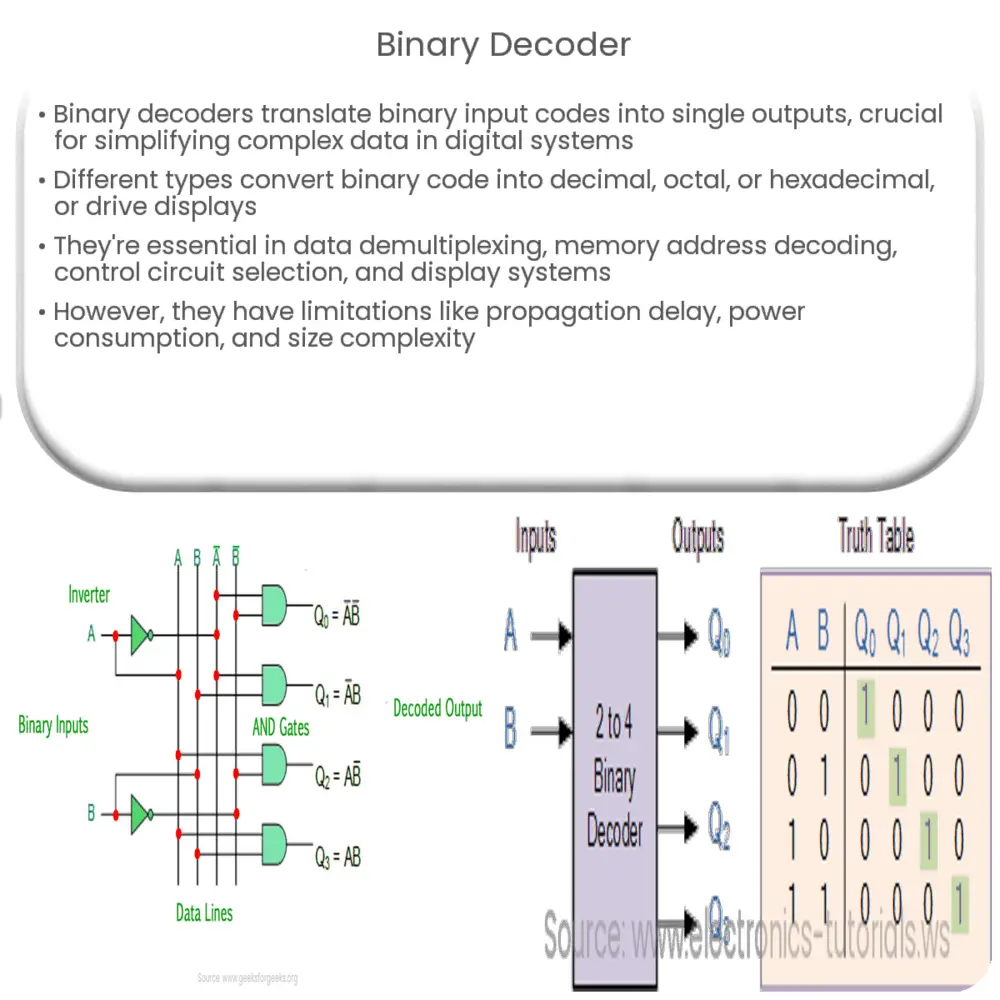A binary decoder is a digital logic device that converts binary input codes into single outputs for use in various electronic systems.

Understanding Binary Decoders: An In-Depth Look
Introduction
A binary decoder is a digital logic device that translates a binary input code into a single output, allowing it to be easily understood and utilized by other devices. It plays a crucial role in simplifying complex binary data, making it an essential component in modern digital systems. This article will explore the basics of binary decoders, their applications, and how they work in various electronic devices.
What is a Binary Decoder?
A binary decoder is a combinational logic circuit that converts a binary code input into a single output, based on the input code’s value. It has n input lines and 2^n output lines, where n represents the number of binary inputs. The output is typically a one-hot encoded representation, meaning that only one output line will be active (high) at a time, corresponding to the input’s binary value.
Types of Binary Decoders
There are several types of binary decoders, which differ in their input and output configurations. The most common types are:
- Binary to Decimal Decoder: This type of decoder has n binary input lines and 2^n decimal output lines. It converts binary code into its corresponding decimal value.
- Binary to Octal Decoder: A binary to octal decoder has 3 binary input lines and 8 octal output lines, converting the binary input into an octal output.
- Binary to Hexadecimal Decoder: This decoder type has 4 binary input lines and 16 hexadecimal output lines, converting the binary code into a hexadecimal output.
- 7-segment Display Decoder: Commonly used to drive 7-segment displays, this decoder has 4 binary input lines and 7 output lines. It converts the binary input into a pattern that can be displayed on a 7-segment display.
Applications of Binary Decoders
Binary decoders play a vital role in digital systems and have numerous applications in various domains. Some of these include:
- Data Demultiplexing: Decoders are often used to distribute data across multiple output lines, based on the input code, allowing for efficient data handling and transmission.
- Memory Address Decoding: In computer systems, decoders are used to determine the location of data within memory by converting a binary address into a unique output line.
- Control Circuit Selection: Decoders help select specific control circuits within a system by interpreting a binary input code and activating the corresponding output line.
- Display Systems: Decoders are utilized in display systems like 7-segment displays and LED matrix displays to interpret binary input data and generate the appropriate output pattern.
How Does a Binary Decoder Work?
A binary decoder operates by employing a series of logic gates, such as AND, OR, and NOT gates, to interpret the input binary code and generate the corresponding output. Each output line is connected to a unique combination of these gates, which only activate when the specific input code is received. This ensures that only one output line is active at a time, providing a clear and unambiguous representation of the input data.
Designing a Binary Decoder
Designing a binary decoder involves a series of steps, including:
- Define the Decoder Specifications: Determine the number of input and output lines required, based on the type of binary decoder and its intended application.
- Develop a Truth Table: Create a truth table that outlines the relationship between the input codes and the corresponding output lines. This table serves as a blueprint for the logic gate connections within the decoder.
- Construct the Logic Circuit: Using the truth table as a guide, create a logic circuit by connecting the appropriate gates in the correct sequence. This circuit will form the core of the binary decoder.
- Test and Optimize: Test the binary decoder to ensure it functions as intended, and optimize the design if necessary to minimize power consumption, size, or complexity.
Limitations of Binary Decoders
Although binary decoders are widely used and highly efficient, they have some limitations, such as:
- Propagation Delay: The time it takes for a signal to pass through the decoder’s logic gates can cause delays in the output, which may impact system performance.
- Power Consumption: Binary decoders can consume a significant amount of power, especially in larger circuits, which may be a concern for energy-sensitive applications.
- Size and Complexity: As the number of input lines increases, the size and complexity of the decoder also grow, which may pose challenges for space-constrained environments.
Conclusion
Binary decoders are indispensable components in modern digital systems, simplifying complex binary data and enabling seamless communication between various electronic devices. By understanding the basics of binary decoders, their types, applications, and design principles, engineers and hobbyists alike can harness the power of these versatile logic devices to develop efficient and robust digital systems.

